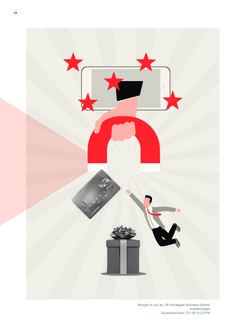| dc.contributor.author | Dorotic, Matilda | |
| dc.date.accessioned | 2019-05-06T09:24:09Z | |
| dc.date.available | 2019-05-06T09:24:09Z | |
| dc.date.created | 2019-05-01T22:01:22Z | |
| dc.date.issued | 2019 | |
| dc.identifier.citation | NIM Marketing Intelligence Review. 2019, 11 (1), 24-29 | nb_NO |
| dc.identifier.issn | 2628-166X | |
| dc.identifier.uri | http://hdl.handle.net/11250/2596565 | |
| dc.description.abstract | The omnipresence of loyalty programs (LP) across markets shows that LPs have been one of the most prominent business trends of the last two decades. Besides their traditional stronghold among airlines and grocery retailers, loyalty reward schemes have spread among nonprofit organizations like museums, charities and sport clubs, among online and offline services, and even among utility providers and business-to-business markets. On average, two-thirds of Europeans belong to at least one LP. In the UK LP penetration reached 90 % and even 94 % in Finland, according to a worldwide Nielsen study in 2016. The 2017 US census by Colloquy reports 3.8 billion LP memberships, with the strongest penetration in the retailing sector to which more than 1.6 billion memberships belong. Beyond reinforcing customer loyalty and retention, LPs can help a retailer increase its share in a customer’s wallet and to cross-sell and up-sell additional products to customers. However, as the number of companies offering LPs soar, the battle for a “place in the consumer wallet” is intensifying, resulting in the fact that more than half of all the memberships that customers sign up for are eventually abandoned, according to Colloquy’s reports. This tendency, coupled with increases in investment costs necessary to leverage benefits from LPs, makes some managers question whether supposed gains from LPs are sustainable. These managers wonder whether investments in LPs should rather be replaced with new musthaves such as mobile marketing, gamification and socialmedia leverage. | nb_NO |
| dc.language.iso | eng | nb_NO |
| dc.publisher | Sciendo | nb_NO |
| dc.rights | Attribution-NonCommercial-NoDerivatives 4.0 Internasjonal | * |
| dc.rights.uri | http://creativecommons.org/licenses/by-nc-nd/4.0/deed.no | * |
| dc.title | Keeping Loyalty Programs Fit for the Digital Age | nb_NO |
| dc.type | Journal article | nb_NO |
| dc.description.version | publishedVersion | nb_NO |
| dc.source.pagenumber | 24-29 | nb_NO |
| dc.source.volume | 11 | nb_NO |
| dc.source.journal | NIM Marketing Intelligence Review | nb_NO |
| dc.source.issue | 1 | nb_NO |
| dc.identifier.doi | https://doi.org/10.2478/nimmir-2019-0004 | |
| dc.identifier.cristin | 1694976 | |
| cristin.unitcode | 158,11,0,0 | |
| cristin.unitname | Institutt for markedsføring | |
| cristin.ispublished | true | |
| cristin.fulltext | original | |

